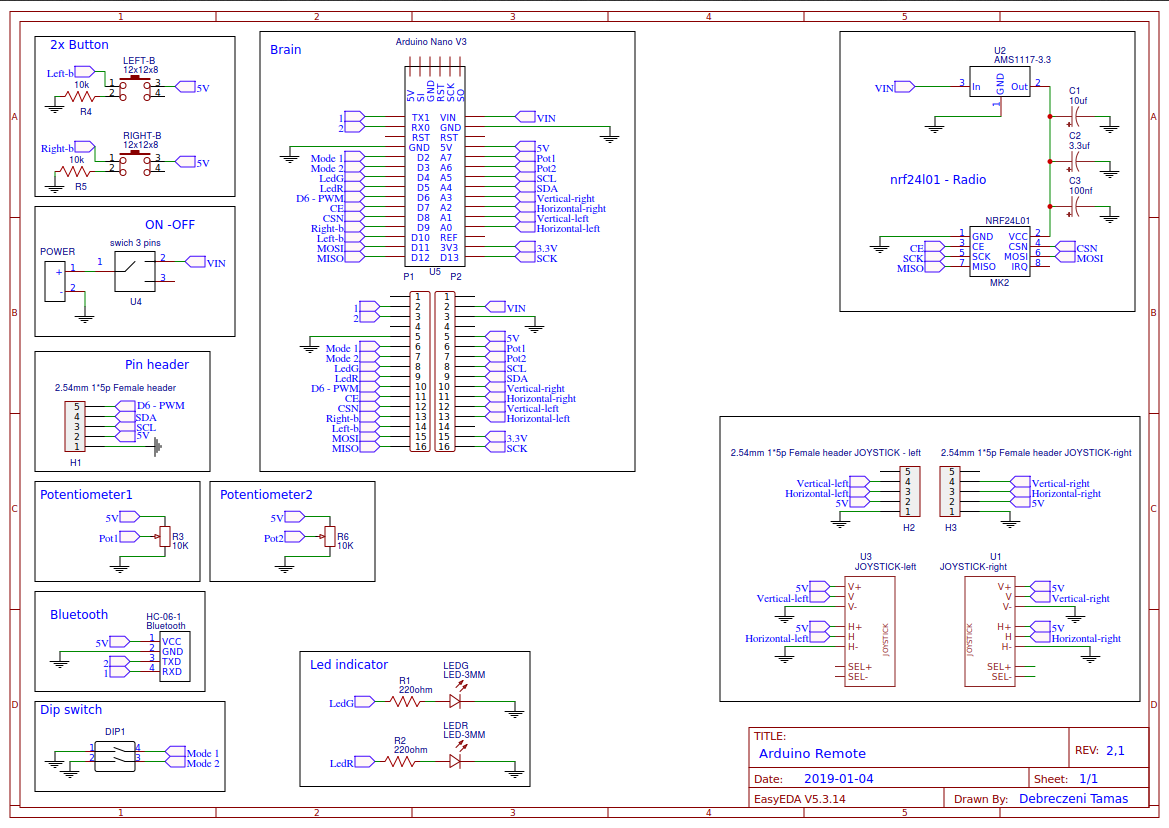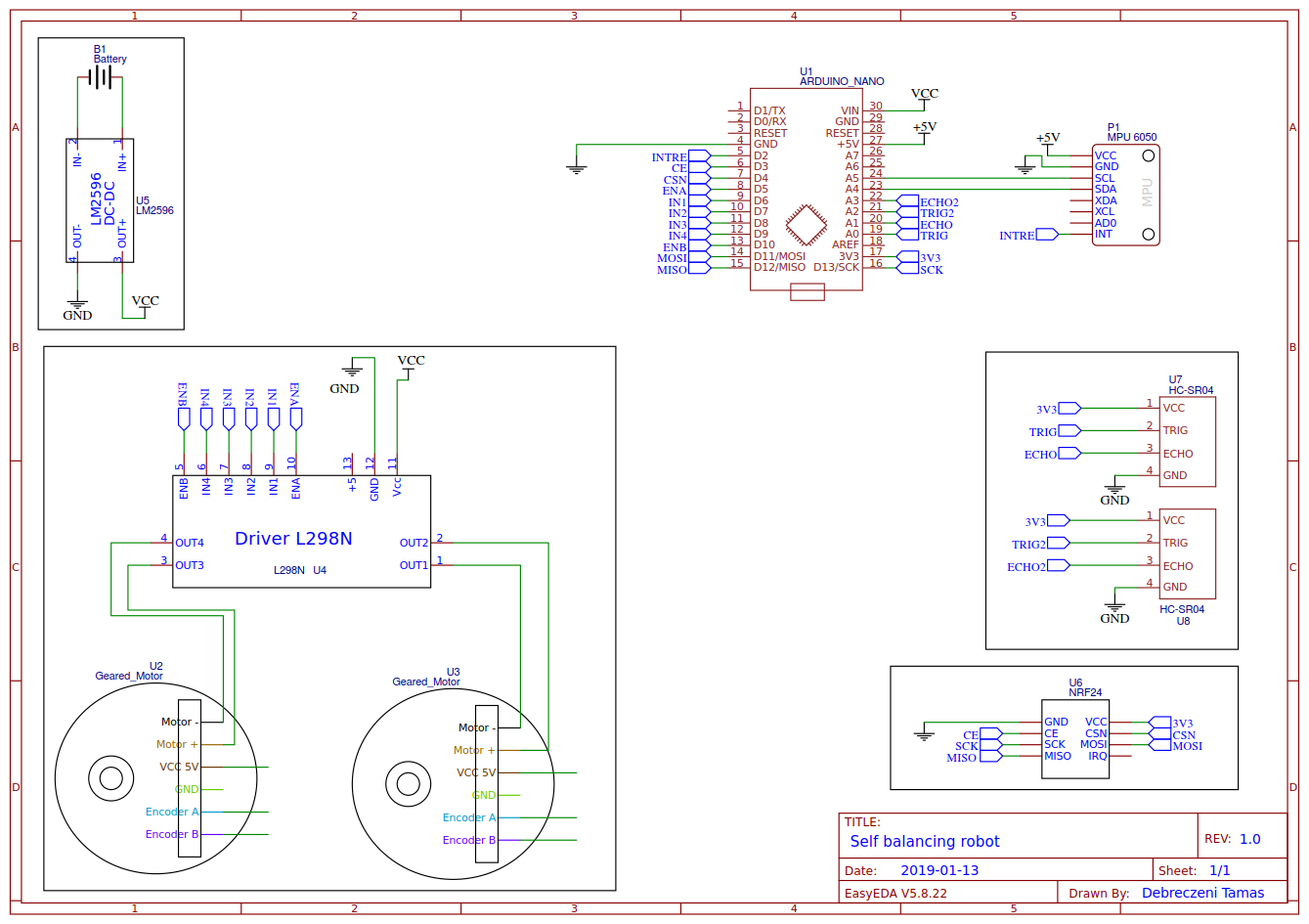#include <PID_v1.h> //PID
#include <LMotorController.h> //Motor driver L298N
#include "I2Cdev.h" //I2C communication
#include "MPU6050_6Axis_MotionApps20.h" //Gyroscope
#include <SPI.h> //SPI communication for NRF24
#include <nRF24L01.h> //NRF24
#include <RF24.h> //NRF24
#include <Ultrasonic.h> //Ultrasonic sensor
#if I2CDEV_IMPLEMENTATION == I2CDEV_ARDUINO_WIRE
#include "Wire.h"
#endif
# define MIN_ABS_SPEED 30 //Minimum motor speed (PWM)
//Motor driver pins
int ENA = 5;
int IN1 = 6;
int IN2 = 7;
int IN3 = 8;
int IN4 = 9;
int ENB = 10;
MPU6050 mpu;
// MPU control/status
bool dmpReady = false; // set true if DMP init was successful
uint8_t mpuIntStatus; // holds actual interrupt status byte from MPU
uint8_t devStatus; // return status after each device operation (0 = success, !0 = error)
uint16_t packetSize; // expected DMP packet size (default is 42 bytes)
uint16_t fifoCount; // count of all bytes currently in FIFO
uint8_t fifoBuffer[64]; // FIFO storage buffer
// orientation/motion
Quaternion q; // [w, x, y, z] quaternion container
VectorFloat gravity; // [x, y, z] gravity vector
float ypr[3]; // [yaw, pitch, roll] yaw/pitch/roll container and gravity vector
//PID parameters
double originalSetpoint = 181.80;
double setpoint = originalSetpoint;
double movingAngleOffset = 0.1;
double input, output;
//
double Kp = 60;
double Kd = 2.2;
double Ki = 270;
PID pid( & input, & output, & setpoint, Kp, Ki, Kd, DIRECT);
//To equalize differences between motors
double motorSpeedFactorLeft = 0.65;
double motorSpeedFactorRight = 0.50;
double OriginalmotorSpeedFactorLeft = 0.65;
double OriginalmotorSpeedFactorRight = 0.50;
LMotorController motorController(ENA, IN1, IN2, ENB, IN3, IN4, motorSpeedFactorLeft, motorSpeedFactorRight);
volatile bool mpuInterrupt = false; // indicates whether MPU interrupt pin has gone high
RF24 radio(3, 4); // CE, CSN
const byte address[6] = "06720"; //NRF adress
unsigned long lastRecvTime = 0; //Used to check for delays
//Structure of received data by radio
struct data {
double left;
double right;
double dir;
double inputValue;
boolean modify;
short inputMode;
boolean ultrasonicSensorOn;
};
data receive_data;
Ultrasonic ultraleft(A2, A3); // (Trig PIN,Echo PIN)
Ultrasonic ultraright(A0, A1); // (Trig PIN,Echo PIN)
int distanceCm;
int distanceCm2;;
int loopNumber = 0;
void dmpDataReady() {
mpuInterrupt = true;
}
//Reset values in case of radio signal loss
void reset_the_Data()
{
receive_data.left = 0;
receive_data.right = 0;
receive_data.dir = 0;
receive_data.ultrasonicSensorOn = true;
}
//Read data received by radio
void receive_the_data()
{
while (radio.available()) {
radio.read( & receive_data, sizeof(data));
lastRecvTime = millis();
}
}
//Select PID parameter that changes
void setInputValue(double inpVal, short inpMode) {
switch (inpMode) {
case 0:
originalSetpoint = inpVal;
break;
case 1:
Kp = inpVal;
break;
case 2:
Kd = inpVal;
break;
case 3:
Ki = inpVal;
break;
}
}
void setup() {
Serial.begin(9600); // open the serial port at 9600 bps:
// join I2C bus (I2Cdev library doesn't do this automatically)
#if I2CDEV_IMPLEMENTATION == I2CDEV_ARDUINO_WIRE
Wire.begin();
TWBR = 24; // 400kHz I2C clock (200kHz if CPU is 8MHz)
#elif I2CDEV_IMPLEMENTATION == I2CDEV_BUILTIN_FASTWIRE
Fastwire::setup(400, true);
#endif
mpu.initialize();
devStatus = mpu.dmpInitialize();
// supply your own gyro offsets here, scaled for min sensitivity
mpu.setXGyroOffset(220);
mpu.setYGyroOffset(76);
mpu.setZGyroOffset(-85);
mpu.setZAccelOffset(1788);
// make sure it worked (returns 0 if so)
if (devStatus == 0) {
// turn on the DMP, now that it's ready
mpu.setDMPEnabled(true);
// enable Arduino interrupt detection
attachInterrupt(0, dmpDataReady, RISING);
mpuIntStatus = mpu.getIntStatus();
// set our DMP Ready flag so the main loop() function knows it's okay to use it
dmpReady = true;
// get expected DMP packet size for later comparison
packetSize = mpu.dmpGetFIFOPacketSize();
//setup PID
pid.SetMode(AUTOMATIC);
pid.SetSampleTime(10);
pid.SetOutputLimits(-255, 255);
} else {
// ERROR!
// 1 = initial memory load failed
// 2 = DMP configuration updates failed
// (if it's going to break, usually the code will be 1)
//Serial.print(F("DMP Initialization failed (code "));
//Serial.print(devStatus);
//Serial.println(F(")"));
}
radio.begin();
radio.setAutoAck(false);
radio.openReadingPipe(0, address);
radio.setPALevel(RF24_PA_MIN);
radio.setDataRate(RF24_250KBPS);
radio.startListening();
}
void loop() {
// if programming failed, don't try to do anything
if (!dmpReady) return;
// wait for MPU interrupt or extra packet(s) available
while (!mpuInterrupt && fifoCount < packetSize) {
//no mpu data - performing PID calculations and output to motors
pid.Compute();
motorController.move(output, MIN_ABS_SPEED);
}
// reset interrupt flag and get INT_STATUS byte
mpuInterrupt = false;
mpuIntStatus = mpu.getIntStatus();
// get current FIFO count
fifoCount = mpu.getFIFOCount();
// check for overflow (this should never happen unless our code is too inefficient)
if ((mpuIntStatus & 0x10) || fifoCount == 1024) {
// reset so we can continue cleanly
mpu.resetFIFO();
//Serial.println(F("FIFO overflow!"));
// otherwise, check for DMP data ready interrupt (this should happen frequently)
} else if (mpuIntStatus & 0x02) {
// wait for correct available data length, should be a VERY short wait
while (fifoCount < packetSize) fifoCount = mpu.getFIFOCount();
// read a packet from FIFO
mpu.getFIFOBytes(fifoBuffer, packetSize);
// track FIFO count here in case there is > 1 packet available
// (this lets us immediately read more without waiting for an interrupt)
fifoCount -= packetSize;
mpu.dmpGetQuaternion( &q, fifoBuffer);
mpu.dmpGetGravity( &gravity, &q);
mpu.dmpGetYawPitchRoll(ypr, &q, &gravity);
input = ypr[1] * 180 / M_PI + 180;
}
receive_the_data();
unsigned long now = millis();
if (now - lastRecvTime > 1000) { //If the delay is greater, reset the data
reset_the_Data();
}
//Direction control with data from remote control
setpoint = originalSetpoint + receive_data.dir;
motorSpeedFactorRight = OriginalmotorSpeedFactorRight + receive_data.right;
motorSpeedFactorLeft = OriginalmotorSpeedFactorLeft + receive_data.left;
if (receive_data.modify) {
setInputValue(receive_data.inputValue, receive_data.inputMode);
PID pid2( & input, & output, & setpoint, Kp, Ki, Kd, DIRECT);
pid2.SetMode(AUTOMATIC);
pid2.SetSampleTime(10);
pid2.SetOutputLimits(-255, 255);
pid = pid2;
}
if (input < 150 || input > 210) {
digitalWrite(ENA, LOW);
digitalWrite(ENB, LOW);
}
//Robot handling with ultrasonic sensors (Setpoint)
if (loopNumber == 2) {
if (receive_data.ultrasonicSensorOn && ultraleft.Ranging(CM) < 30 && ultraleft.Ranging(CM) != 0) {
setpoint = originalSetpoint - 4;
} else {
if (receive_data.ultrasonicSensorOn && ultraright.Ranging(CM) < 30 && ultraright.Ranging(CM) != 0) {
setpoint = originalSetpoint + 4;
}
}
loopNumber = 0;
}
loopNumber++;
}
















_3u05Tpwasz.png?auto=compress%2Cformat&w=40&h=40&fit=fillmax&bg=fff&dpr=2)

Comments